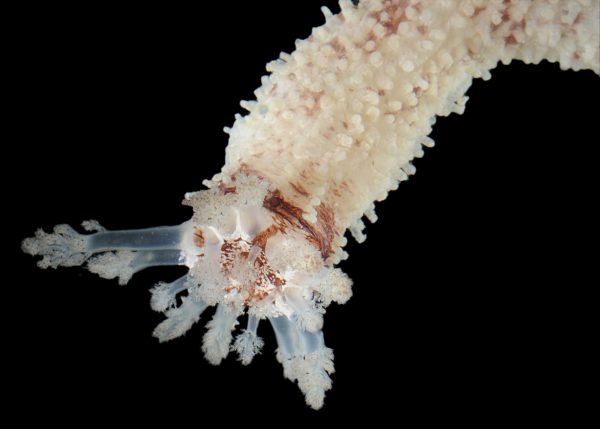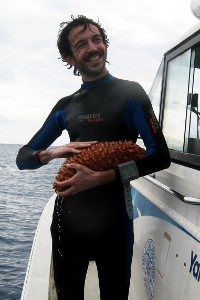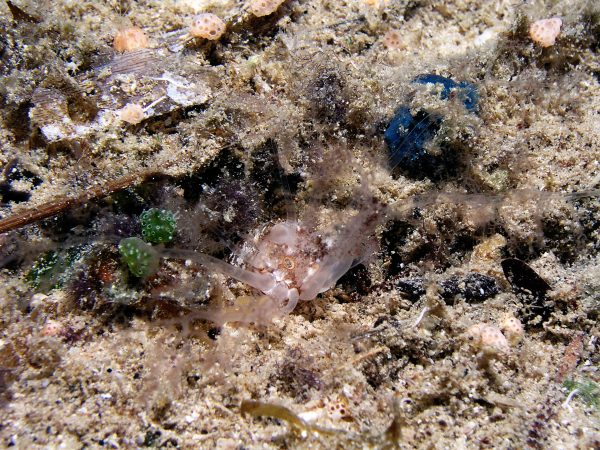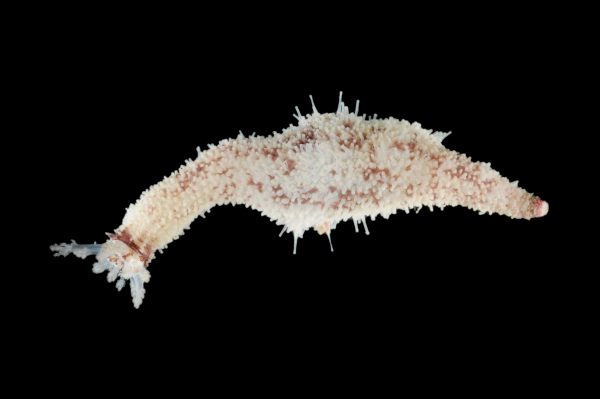
Florida Museum photo by François Michonneau
Scientists at the Florida Museum of Natural History have discovered that a group of tiny sea cucumbers has enormous taxonomic problems.
The use of DNA analyses in taxonomic research has increased in recent years, making it possible for scientists to better understand poorly known species and build knowledge of Earth’s more obscure biodiversity. This type of work is exemplified by the research of François Michonneau, a former invertebrate zoology Ph.D. student with the Florida Museum, who studies the oceans’ most diverse order of sea cucumbers, Dendrochirotida, which includes many small species—most only a few centimeters in length. Studying Phyrella, a genus of Dendrochirotida, Michonneau found that several species of sea cucumbers may be assigned inaccurately within the order.
“The systematics of sea cucumbers is messy and full of inaccuracies,” Michonneau said. “Our revision is just touching the tip of the iceberg as far as cleaning up the confused state of taxonomy in the order Dendrochirotida. The purpose of our study is to identify the appropriate traits to classify sea cucumbers at the genus and species levels.”
Michonneau collaborated with the Florida Museum’s invertebrate zoology curator Gustav Paulay to publish an article about the revision of the group in the online journal Zootaxa in January 2014. The study is the first taxonomic revision in this group to use DNA to test morphological characteristics that scientists have traditionally relied upon to identify and classify species in this order. Using DNA to guide taxonomic revisions has allowed scientists to group species according to their evolutionary history more accurately than by relying only on morphological similarities, Michonneau said.

Photo courtesy of Alex Kerr, University of Guam
The tropical genus Phyrella had not been reviewed since it was established in 1953. The new revision was prompted by the discovery of a new species of Phyrella collected by Michonneau in Guam in 2010, which, along with new specimens from biodiversity surveys in Australia and Japan, allowed researchers to revise and complete the original descriptions, as well as explore their relationship based on molecular data.
Guam has been an important location for sea cucumber taxonomy studies for nearly 200 years due to the diversity of sea cucumbers and long history of expeditions and work by resident taxonomists. While the sea cucumber fauna of Guam are among the best documented of any tropical area, scientists continue to discover new species in the hyper-diverse island environment.
Paulay said the sea cucumber fauna was thought to be well documented around the island, but a week-long workshop sponsored by the National Science Foundation in 2010 yielded new species and numerous new records. Guam’s identified sea cucumbers now total 65 species in 17 genera and seven families.
After digging deeper into the history of Phyrella, Michonneau quickly discovered not all species assigned to the genus belonged there, while other related species may need to be transferred to Phyrella.
“Sea cucumbers, like most marine animals, are very poorly known,” Paulay said. “This study is a complete reshuffling and it shows that our knowledge is inadequate.”

Photo courtesy of David Burdick
Much of what scientists have learned in the past about biodiversity has come from collecting specimens in the field or discovering new species in museum collections, followed by numerous hours spent studying the morphology of the specimen and describing the species. By using DNA analyses, scientists can better understand how species relate to each other.
“With sea cucumbers, there are not a lot of morphological characteristics that scientists can use to identify and classify species, which can lead to a lot of confusion in the field,” Michonneau said. “Species have often been assigned to the wrong genus because traits used for classification were too unreliable. Variation at the species level was not taken into account.”
Phyrella, traditionally thought only to include species with 20 tentacles, actually includes species with between 15 and 20 tentacles. By using DNA analyses and several specimens, the results gave scientists a better understanding of the variation in traits that can be used to identify and classify Phyrella species, Michonneau said.

Florida Museum photo by François Michonneau
By determining classification errors in Phyrella, Michonneau said his research shows the taxonomy of Dendrochirotida needs to be significantly re-evaluated.
“The next step is to use genetic data to thoroughly investigate the characteristics used in classification,” he added. “If the data from DNA is integrated with geographical evidence and other information about the organism like we did here, then it’s very useful for taxonomic studies and other scientific questions.”
Taxonomic research that utilizes molecular data also provides a better foundation for conservation and ecological work. For the majority of animals in most parts of the world, there are no field guides to identify them, and resources to allow identification must be created before biodiversity can be effectively studied, Paulay said.
“If you want to conserve species, the first thing you do is identify what is around you,” Paulay said. “If you cannot identify a species, you cannot determine if it is endangered. Scientists do not know much about organisms like sea cucumbers that live on coral reefs, or a lot of what we do know is wrong.”
Learn more about the Invertebrate Zoology at the Florida Museum.